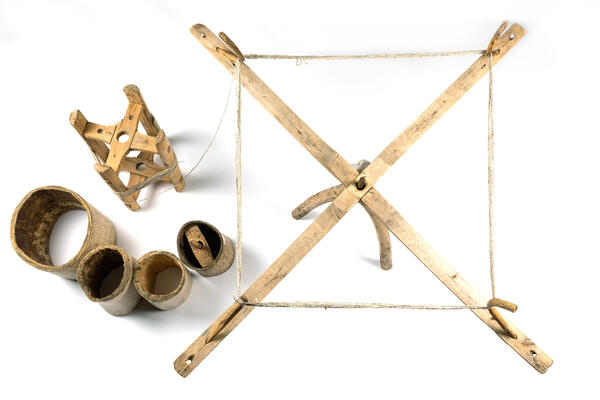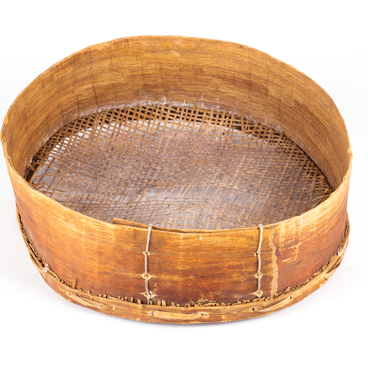In Russia, an important place in everyday life was occupied by industries associated with processing wool and plant fibers. An integral part of these crafts was the thread winder — a device that was used in home weaving to rewind threads from a skein onto a reel or spools. The spools were usually made of wood or birch bark, and had the shape of a hollow cylinder. The museum’s exposition has spools with four different diameters.
The thread winder is a wooden stand with a sharp point at the top end. Two bars that crossed each other were mounted on the top, and at their ends pegs were placed that were about 100–110 centimeters long. The bars rotated around a fixed vertical axis. The axis of rotation was a metal or wooden rod driven into a wooden support. Most often, the stand was made from a thin piece of wood. It could be fixed on a crosspiece, a board mounted on planks, or a piece of tree trunk with 2–3 roots. Thread winders had holes into which 4 empty spindles were stuck to hold the skein. The skein of thread was straightened on pegs and the thread was fixed by one end to the spool: when it rotated, it set the thread winder in motion, and the thread from the thread winder was rewound onto it.
In Russia, preparation for weaving usually took 10 months. One of the most important parts was spinning — the process of longitudinally folding and twisting plant fibers into a spiral to produce a long, strong thread. The threads that were spun had different thicknesses: in weaving, the best — thinner and stronger — threads were used for the vertical warp, and lower quality, thicker threads were used for the horizontal weft. For spinning, the peasants had to get many spindles ready beforehand with spun thread. Rural craftsmen understood this craft so well that they could determine with great accuracy how many threads would come out on a spindle from a handful of raw flax just by looking at it.
Making the threads themselves was the most difficult and time-consuming process in the production of fabric. In addition to flax, which was extremely commonplace, threads were also often made from other plants like nettle or hemp. After the spinning was completed, the warp weave had to be made: a certain number of threads needed to be measured off, and threads with different qualities had to be selected. This work began in the early spring, during Great Lent. The skeins of thread were subsequently wound on a thread winder, which was most often made from aspen wood.
The thread winder is a wooden stand with a sharp point at the top end. Two bars that crossed each other were mounted on the top, and at their ends pegs were placed that were about 100–110 centimeters long. The bars rotated around a fixed vertical axis. The axis of rotation was a metal or wooden rod driven into a wooden support. Most often, the stand was made from a thin piece of wood. It could be fixed on a crosspiece, a board mounted on planks, or a piece of tree trunk with 2–3 roots. Thread winders had holes into which 4 empty spindles were stuck to hold the skein. The skein of thread was straightened on pegs and the thread was fixed by one end to the spool: when it rotated, it set the thread winder in motion, and the thread from the thread winder was rewound onto it.
In Russia, preparation for weaving usually took 10 months. One of the most important parts was spinning — the process of longitudinally folding and twisting plant fibers into a spiral to produce a long, strong thread. The threads that were spun had different thicknesses: in weaving, the best — thinner and stronger — threads were used for the vertical warp, and lower quality, thicker threads were used for the horizontal weft. For spinning, the peasants had to get many spindles ready beforehand with spun thread. Rural craftsmen understood this craft so well that they could determine with great accuracy how many threads would come out on a spindle from a handful of raw flax just by looking at it.
Making the threads themselves was the most difficult and time-consuming process in the production of fabric. In addition to flax, which was extremely commonplace, threads were also often made from other plants like nettle or hemp. After the spinning was completed, the warp weave had to be made: a certain number of threads needed to be measured off, and threads with different qualities had to be selected. This work began in the early spring, during Great Lent. The skeins of thread were subsequently wound on a thread winder, which was most often made from aspen wood.



